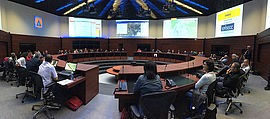At the Civil Protection Center in Palmanova, Italy, the research project EPISECC* , funded by the European Community’s Seventh Framework Programme FP7, demonstrated innovative information technology to enable interoperability between public safety agencies. The electronic information exchange between these stakeholders will aide them in response to large disasters, such as floods, earthquakes, forest fires, technical incidents, or terrorist attacks.
The exercise took place on May 11-12, 2017 and successfully tested the interoperability of information systems from the civil protection authority, fire fighters, mountain rescue teams and paramedics of Italy, Slovenia and Austria. The EPISECC project aims to develop the concept of a “Common Information Space” to become the key element in a future integrated Pan-European crisis and disaster response capacity.
A group of highly ranked observers (experts from first responders, crisis managers and international organisations) evaluated the demonstrated concepts and prototype and provided very positive feedback to the EPISECC team. The next challenge will be the transformation of the research results into marketable solutions and to introduce them into the operational disaster management procedures.
“Disaster-affected people need information as much as water, food, medicine or shelter: accurate, timely information can save lives. Today’s information technology presents new possibilities, but has not been fully exploited by humanitarian organizations. Lack of information can make people victims of disaster.” World Disaster Report (2013) International Federation of Red Cross.
“The information space, developed under EPISECC, aims to overcome key challenges hindering efficient crisis response, namely compatibility and linguistic barriers and lack of interoperability. The strength of EPISECC is that it does not force stakeholders to change their operating systems or standard working procedures, not even the language that its staff is working in. The outcomes of the project demonstrate that technological improvements possess great potential to foster efficient disaster response” says Gudrun Van Pottelbergh, crisis management expert and observer in Palmanova exercise.
*The EPISECC consortium consists of 12 partners out of 9 European countries:
Airbus, AIT Austrian Institute of Technology, Deutsches Zentrum f. Luft- und Raumfahrt, Frequentis, HITEC, HWCommunications, IES Solutions, KU Leuven, PSC Europe, TCCA, TU Graz, University of Split



